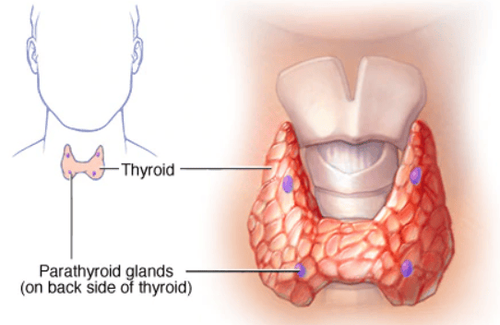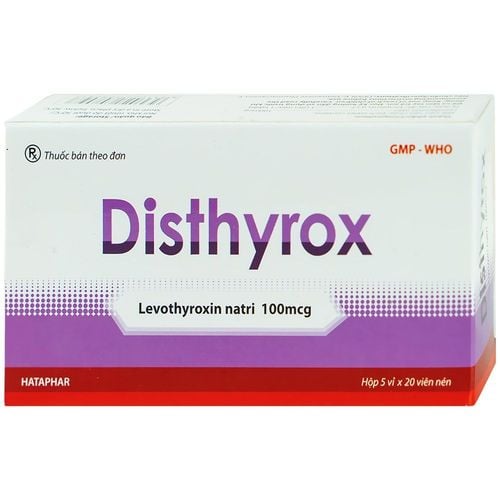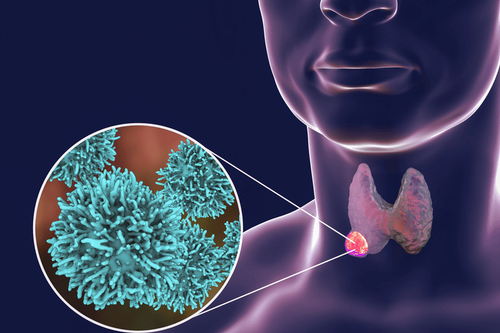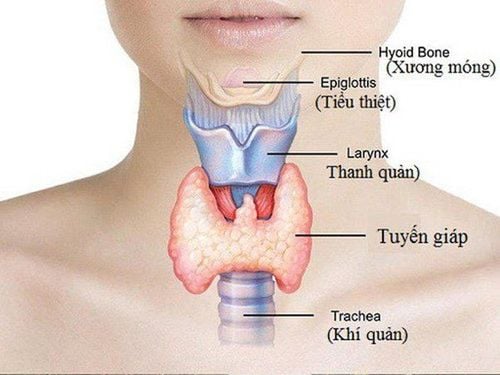This is an automatically translated article.
The article is professionally consulted by Master, Doctor Le Xuan Thiep - Radiologist - Department of Diagnostic Imaging - Vinmec Ha Long International Hospital. The doctor has extensive experience in the field of diagnostic imaging.Imaging plays an important role in diagnosing thyroid diseases. In which, typical tests are CT scan, PET/CT and thyroid scan.
1. What is thyroid disease?
The thyroid is a small, butterfly-shaped gland located in the front of the neck that surrounds the windpipe. The two halves of the thyroid gland are connected by a thin layer of tissue. The thyroid gland uses iodine to produce the hormones T3, T4, which help control how the body uses energy.The levels of T3 and T4 hormones secreted are controlled by the pituitary gland and the hypothalamus. These two hormones both circulate in the blood, helping to regulate metabolism. Depending on the level of T4 in the body, the pituitary gland produces more or less TSH, in order to regulate the amount of T4 at an appropriate level.
Thyroid disease occurs when the thyroid gland does not function properly, releasing too much or not enough T4 hormone. In which, there are three common types of thyroid disease including:
Hypothyroidism (underactive thyroid) Hyperthyroidism (overactive thyroid) Thyroid cancer 1.1. Hypothyroidism (underactive thyroid) Hypothyroidism occurs when the thyroid gland does not produce enough T4 hormone. It can happen because of the pituitary gland, the hypothalamus, or the thyroid gland itself. Nearly 5% of the population has hypothyroidism, with a higher percentage of women than men. Symptoms of hypothyroidism include:
High cholesterol Depression Fatigue Fatigue Hair loss Memory loss Extremely dry skin Feeling cold Constipation

Suy giáp xảy ra khi tuyến giáp sản xuất không đủ hormone T4
Symptoms of hyperthyroidism include:
Restlessness Anxiety Trembling Weight loss Fast heart rate Sweating Can't stand feeling hot Irregular periods Thin skin Sleep changes Increased bowel movements Goiter Large patients age may have arrhythmia, heart failure and psychosis (delirium). If left untreated, a patient can develop a "thyroid storm" in which high blood pressure, heart failure, and fever can be life-threatening or even fatal.
1.3. Thyroid cancer Thyroid cancer occurs when there is a structural change in the thyroid cells that causes them to multiply, forming cancerous cells. If left untreated, cancer cells can spread to the lymph nodes, surrounding tissues, and blood vessels. The disease is curable if detected early and treated promptly. Thyroid cancer includes the following 4 diseases:
Papillary thyroid cancer: 70% of patients with thyroid cancer are diagnosed with papillary thyroid cancer. It occurs in the follicular cells, where thyroid hormone is stored. The disease progresses slowly, but up to 20% of patients have metastatic cancer to the lymph nodes of the neck at the time of diagnosis. Follicular thyroid cancer: This disease also begins in follicular cells. However, it is more active, the cells often metastasize to the lungs or bones. A rare form of follicular thyroid cancer is Hurthle cell carcinoma, with a higher rate of detection when metastasized than other differentiated thyroid cancers. Most patients with follicular thyroid cancer are over the age of 40. Medullary thyroid cancer: Only 4% of patients with thyroid cancer are diagnosed with medullary thyroid cancer. It develops in the C cells of the thyroid gland that make a hormone called calcitonin. Calcitonin helps the body maintain stable calcium levels. The cause of the disease can come from other types of cancer, can also be genetic. The cure rate is lower than papillary or follicular thyroid cancer. However, the 10-year survival rate is as high as 90% when the disease occurs only in the thyroid gland. Undifferentiated thyroid cancer: The disease occurs in only 1% of patients with thyroid cancer. This is the most difficult form of thyroid cancer to treat. It can occur with follicular or papillary thyroid cancer or goiter. Most patients with this disease are over the age of 60 and have no metastases at the time of diagnosis.

Ung thư tuyến giáp xảy ra khi có sự thay đổi cấu trúc các tế bào tuyến giáp khiến chúng nhân lên, hình thành các tế bào ung thư
Thyroiditis : The disease often occurs without a known cause. In some cases, the cause is indicated to be a viral, bacterial, or postpartum infection. Inflammation causes excess thyroid hormone to leak into the bloodstream, causing hyperthyroidism. The period of hyperthyroidism usually does not last more than three months. Eventually, the thyroid becomes underactive, and the release of the hormone T4 gradually decreases or stops permanently. Usually, inflammation is not accompanied by pain. However, for patients with subacute thyroiditis, pain in or around the thyroid gland may persist for several weeks. Hashimoto's Thyroiditis: It occurs when the immune system makes antibodies to attack the thyroid gland, causing it not to produce enough thyroid hormone to serve the body. It can be caused by viruses or bacteria that cause an overactive immune response and genetic factors. People with other autoimmune disorders such as arthritis, lupus, type 1 diabetes, exposure to radioactive substances have a higher risk of disease than the general population. Pituitary or hypothalamic disease: Because the thyroid gland is regulated by the pituitary gland and hypothalamus, injury or dysfunction in these areas can impair thyroid function, causing secondary hypothyroidism. Radiation therapy: Patients who have used radioactive iodine to treat hyperthyroidism will often develop hypothyroidism after treatment. Patients who receive external beam radiation therapy (EBT) to the thyroid, neck, or chest for cancer treatment may also experience thyroid dysfunction. Basedow's disease: The most common cause of hyperthyroidism is basedow's disease. It occurs when the immune system produces antibodies that cause the thyroid gland to make more of the hormone T4 than the body needs. In healthy individuals, T4 levels are regulated by the hormone TSH. Meanwhile, patients with basedow release antibodies that mimic TSH and trick the thyroid gland into producing more T4 than it needs, leading to hyperthyroidism. Antibodies that attack the thyroid gland also often attack the tissues behind the eyes, causing thyroid eye disease. It can cause mild symptoms such as red and irritated eyes, sensitivity to light, bulging eyes due to inflammation, and swelling in the muscles and tissues in the eye sockets. Patients with basedow's disease may also experience redness or thickening of the skin on the front of the lower leg. Hyperthyroidism: Noncancerous nodules called adenomas, which occur when part of the thyroid gland swells and separates from the rest of the gland. They can produce thyroid hormone independently of the rest of the thyroid gland (active nodules). When these nodules do not respond to the normal feedback mechanisms that check thyroid hormone levels, they are called toxic adenoma or thyrotoxic nodules (Plummer's disease).
2. How is thyroid disease diagnosed and evaluated?
Assessment based on clinical symptoms: Patients often come to the clinic for reasons such as fatigue, inability to get pregnant, skin and hair changes, a lump in the neck, hoarseness or pain in the gland. armor.For definitive diagnosis, the indication used is a blood test to measure thyroid hormone levels. If abnormal results are related to thyroid cancer, the patient will be ordered to perform additional tests:
Thyroid scan: In a thyroid scan, a small amount of iodine is absorbed into the thyroid gland after introduced into the body. After a few hours, a special camera will be placed in front of the neck to measure the amount of iodine absorbed by the thyroid gland. This device does not emit radiation, but is contaminated with a small amount of radioactive iodine that is introduced into the body. Ultrasonic-guided fine-needle aspiration biopsy (core needle biopsy (CNB), or fine-needle aspiration cytology (FNA) under ultrasound guidance): In biopsy, aspiration of thyroid CELLs, a thin, hollow needle is inserted through the skin (under ultrasound guidance) into the thyroid or lymph nodes with suspected disease. A small sample of tissue OR CELLS is removed for examination under a microscope to determine if cancer is present. Imaging tests (CT scan, PET/CT, whole body thyroid scan) : Tests are indicated when thyroid cancer has been confirmed to determine the size, location of the tumor and assess the extent. metastasis, monitoring response assessment after treatment. Now with the advancement of science and technology thyroid tumors, even thyroid cancer can be treated under ultrasound guidance. microwave (Microway) ... brings high efficiency, minimally invasive.

Trong xạ hình tuyến giáp, một lượng nhỏ iốt sẽ hấp thu vào tuyến giáp sau khi được đưa vào cơ thể
3. How is thyroid disease treated?
3.1. Hypothyroidism (underactive thyroid) Patients with hypothyroidism are often prescribed a synthetic thyroid hormone called levothyroxine (Synthroid). Levothyroxine works to restore hormone levels. help relieve symptoms. Blood tests will be periodically checked to assess the effectiveness of the medication. It takes several months of trial and error before the right dose is found. People with hypothyroidism need to take thyroid hormone replacement medication for the rest of their lives.3.2. Hyperthyroidism (overactive thyroid) Treatment for patients with hyperthyroidism depends on the severity of symptoms and the underlying cause. Here are some options:
Antithyroid drugs : Methimazole (Tapazole) works by preventing too much thyroid hormone from being produced. It is often used for patients with basedow's disease or before thyroid surgery. Symptoms usually subside within 6-12 weeks of starting the drug, but treatment usually continues for at least a year. 20 - 30% of patients experience permanent pain relief while others develop symptoms again. Antithyroid drugs can affect the liver and increase the risk of infection. There are a small number of people who are allergic to these drugs. Radioactive iodine: Radioactive iodine (I-131) is commonly used in the treatment of hyperthyroidism. Iodine taken into the body will be absorbed into the thyroid gland to destroy gland cells. In about 3 - 6 months of treatment, patients gradually reduce symptoms. Radioactive iodine often makes the thyroid underactive, many people need to take synthetic thyroid hormone daily to restore hormone levels in the body. Radioactive iodine has been used for decades and has been shown to be safe. Beta-blockers: This is a class of drugs used to treat high blood pressure. Medications do not directly treat the thyroid gland, but can help reduce tachycardia and prevent heart palpitations. Beta blockers are often used along with antithyroid drugs and radioactive iodine to help gradually reduce symptoms until they recover. Beta-blockers are generally well-tolerated, but can cause side effects in some people, such as stomach upset, diarrhea, dizziness, or headache. Surgery (thyroidectomy): For patients who cannot take antithyroid drugs or radioactive iodine, surgical removal of the thyroid gland is a good option. The procedure is done by making an incision at the base of the neck and removing most of the thyroid gland. In minimally invasive thyroidectomy, the incision is smaller under the guidance of a video camera. Most surgeries last from 2 to 2 hours. The patient either returned home the same day or the next day, after the follow-up period. Surgical complications rarely occur. Some of these complications can be avoided, such as damage to the parathyroid glands (causing low calcium levels) or vocal cords (causing hoarseness). Once the thyroid gland is removed, the patient needs to take the synthetic hormone Synthroid for life. Patients need calcium supplements if the parathyroid glands are also removed. 3.3. Thyroid cancer Most types of thyroid cancer are treated with thyroidectomy. Radioactive iodine therapy is often used after surgery to remove all remaining thyroid tissue. Depending on the stage of the cancer, lymph nodes in the neck are also used to check if the cancer has spread.
In some cases where the cancer occurs in only part of the thyroid gland, the type of surgery used is a lobectomy. After surgery, most patients need to take synthetic thyroid hormone daily for the rest of their lives.
Currently, Vinmec International General Hospital has a package of screening and screening for thyroid diseases. When choosing the Package of Screening and Screening for Thyroid Diseases at Vinmec, you will be examined by experienced thyroid specialists to help screen and detect common thyroid diseases early. variables such as: simple goiter, hyperthyroidism, hypothyroidism, thyroiditis, thyroid nodules, thyroid cancer,...
At the same time, you will have blood tests, evaluate levels of functional hormones thyroid such as FT3, FT4, TSH, Anti - TPO, Anti TG and ultrasound, scan to evaluate the structure of the thyroid gland. After that, when the results are returned to the doctor, you will be consulted about thyroid pathology, and discuss the appropriate treatment options for yourself. From there, thyroid disease will be prevented in time, avoiding long-term health damage in the future.
Please dial HOTLINE for more information or register for an appointment HERE. Download MyVinmec app to make appointments faster and to manage your bookings easily.
SEE MORE
Common symptoms warning thyroid disease Signs that you need a thyroid ultrasound Thyroid tumor: Diagnosed benign - how malignant?













